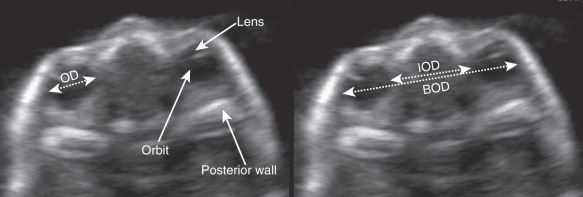Abstract
Orbital defects are rarely diagnosed in the fetus. However, these anomalies are highly associated with chromosomal and nonchromosomal defects. This chapter aims to describe the systematic evaluation of fetal orbits using ultrasound (US) to identify most common anomalies. Hypertelorism, which is increased interocular distance, is rarely associated with chromosomal abnormalities but is highly associated with nonchromosomal syndromes. Isolated hypertelorism is very rare; therefore an anatomic scan and karyotype analysis are necessary in order to detect malformations or chromosomal abnormalities. The prognosis depends on the underlying syndrome or associated anomalies. Hypotelorism, which is decreased interocular distance, is highly associated with chromosomal abnormalities, most commonly diagnosed is trisomy 13. In most cases it is associated with holoprosencephaly. Isolated hypotelorism is exceptional, therefore once it is diagnosed, a karyotype and anatomic scan, mainly focused on central nervous system evaluation, should be performed in order to detect holoprosencephaly or other associated malformations. General prognosis is poor due to a high mortality rate in cases associated with trisomy 13 and severe mental retardation in those cases associated with holoprosencephaly.
Keywords
interocular distance, holoprosencephaly, trisomy 13
Introduction
Orbits can be identified from 10 to 12 weeks of gestation by transvaginal ultrasound. On ultrasound evaluation, orbits appear as echolucent circles, and inside these structures lenses can be indentified as small echogenic circular structures. In normal development, ocular structures develop laterally and migrate toward the midline to reach their final position. Orbital defects are rarely diagnosed in the fetus. However, these anomalies are highly associated with chromosomal and nonchromosomal defects.
Hypertelorism
Definition
Hypertelorism is defined by an increased interocular distance (IOD) above the 95th centile.
Prevalence and Epidemiology
This is a very rare condition.
Etiology and Pathophysiology
Three different mechanisms have been proposed to be responsible for this anomaly: (1) primary arrest of the migration process, (2) secondary arrest of migration due to the presence of a midline tumor, which mechanically limits migration, and (3) abnormal development and growth of the cranial bones.
Manifestations of Disease
Clinical Presentation
Hypertelorism is rarely associated with chromosomal abnormalities, but is highly associated with nonchromosomal syndromes, mainly in the face, central nervous system (CNS), or cranial bones. Some syndromes detectable in utero are listed in Table 66.1 . Isolated hypertelorism is very rare; therefore an anatomic scan and karyotype analysis are necessary in order to detect malformations or chromosomal abnormalities. The prognosis depends on the underlying syndrome or associated anomalies.
| Hypertelorism associated with: | Syndrome |
|---|---|
| Anterior cephalocele, median cleft lip, and bifid nose | Frontonasal dysplasia |
| Turricephaly, macroglossia, syndactyly, fusion of cervical vertebrae, renal anomalies, and heart anomalies | Apert syndrome |
| Cataract, microcephaly, agenesis of the corpus callosum, severe cerebellar hypoplasia, micrognathia, short limbs, syndactyly, joint contractures, early-onset fetal growth retardation, and polyhydramnios | Neu-Laxova syndrome |
Imaging Technique and Findings
Ultrasound.
Ultrasound (US) diagnosis is made on the axial view of the orbits (lateral or ventral approach) by measuring IOD. Orbital biometry is not routinely assessed but it should be checked whenever there is suspicion of an orbital anomaly. Orbits can be assessed easily by US in an axial plane slightly caudal to the biparietal diameter plane. Ocular diameter, interocular distance, and binocular distance can be determined either in lateral or coronal planes. Additionally, a ventral view can be useful to assess the intraocular soft tissues, lenses, and posterior walls of the orbits ( Fig. 66.1 ). Normal values for ocular measurements in early gestation, midgestation, and late gestation are available. Measurements are particularly useful in moderate hypertelorism ( Fig. 66.2 ), while in severe, very obvious cases ocular biometry may be unnecessary.











